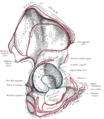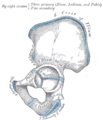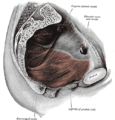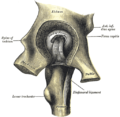Pubis (bone)
| Pubis (bone) | |
|---|---|
 Pelvic girdle | |
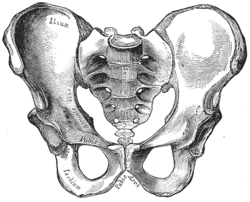 Male pelvis with pubis at bottom | |
| Details | |
| Part of | Pelvis |
| Identifiers | |
| Latin | os pubis |
| MeSH | D011630 |
| TA98 | A02.5.01.301 |
| TA2 | 1346 |
| FMA | 16595 |
| Anatomical terms of bone | |
In
Structure
The pubic bone is made up of a body, superior ramus, and inferior ramus (
Body
The body of pubis has:
- a superior border or the pubic crest
- a pubic tubercle at the lateral end of the pubic crest
- three surfaces (anterior, posterior and medial).
The body forms the wide, strong, middle and flat part of the pubic bone. The bodies of the left and right pubic bones join at the
Superior pubic ramus
The superior pubic ramus is the upper of the two rami. It forms the upper edge of the obturator foramen.[4] It extends from the body to the median plane where it joins with the ramus of the opposite side. It consists of an inner flattened part and a narrow outer prismoid portion.
Medial surface
Surfaces
- The anterior surface is rough, directed downward and outward, and serves for the origin of various muscles. The adductor brevis and the upper part of the gracilistake origin.
- The posterior surface, convex from above downward, concave from side to side, is smooth, and forms part of the anterior wall of the pelvis. It gives origin to the puboprostatic ligamentsand to a few muscular fibers prolonged from the bladder.
Borders
The upper border presents a prominent tubercle, the
Passing upward and laterally from the pubic tubercle is a well-defined ridge, forming a part of the
Medial to the pubic tubercle is the crest, which extends from this process to the medial end of the bone. It affords attachment to the inguinal falx, and to the
The point of junction of the crest with the medial border of the bone is called the angle; to it, as well as to the
The medial border is articular; it is oval, and is marked by eight or nine transverse ridges, or a series of nipple-like processes arranged in rows, separated by grooves; they serve for the attachment of a thin layer of cartilage, which intervenes between it and the interpubic fibrocartilaginous lamina.
The lateral border presents a sharp margin, the obturator crest, which forms part of the circumference of the obturator foramen and affords attachment to the obturator membrane.
Lateral portion
Surfaces
- The superior surface presents a continuation of the iliopectineal eminence, which serves to indicate the point of junction of the ilium and pubis, and below by a prominent ridge which extends from the acetabular notchto the pubic tubercle.
- The inferior surface forms the upper boundary of the obturator foramen, and presents, laterally, a broad and deep, oblique groove, for the passage of the obturator vessels and nerve; and medially, a sharp margin, the obturator crest, forming part of the circumference of the obturator foramen, and giving attachment to the obturator membrane.
- The posterior surface constitutes part of the anterior boundary of the lesser pelvis. It is smooth, convex from above downward, and affords origin to some fibers of the obturator internus.
Inferior pubic ramus
The inferior pubic ramus is a part of the pelvis and is thin and flat. It passes laterally and downward from the medial end of the superior ramus; it becomes narrower as it descends and joins with the
Surfaces
- Its anterior surface is rough, for the origin of muscles—the adductores brevisand magnus, the former being the more medial.
- The posterior surface is smooth, and gives origin to the constrictor urethrae.
Borders
- In the female pelvis, the medial border is thick, rough, and everted, and presents two ridges, separated by an intervening space. The ridges extend downwards, and are continuous with similar ridges on the inferior ramus of the ischium;
- to the external ridge is attached the fascia of Colles
- to the internal ridge is attached the inferior fascia of the urogenital diaphragm
- The lateral border is thin and sharp, forms part of the circumference of the obturator foramen, and gives attachment to the obturator membrane.
Other animals
Mammals
Non-
Placentals are unique among all mammals, including other
Dinosaurs
The
-
Ornithischian pelvic structure (left side)
-
Saurischian pelvic structure (left side).
Additional images
-
The sacrum and pelvic bone, with parts labelled. The pubic bone consists of the body and superior pubic ramus (4), and the inferior pubic ramus (3), which join at the pubic symphysis. The gap between them is the obturator foramen.
-
Right hip bone. External surface.
-
Right hip bone. Internal surface.
-
Plan of ossification of the hip bone.
-
Symphysis pubis exposed by a coronal section.
-
Left levator ani from within.
-
The obturator externus.
-
Left hip-joint, opened by removing the floor of the acetabulum from within the pelvis.
-
Pubis
See also
References
![]() This article incorporates text in the public domain from page 236 of the 20th edition of Gray's Anatomy (1918)
This article incorporates text in the public domain from page 236 of the 20th edition of Gray's Anatomy (1918)
- ^ "Definition: body of pubis from Online Medical Dictionary". Retrieved 2008-10-18.
- ^ "crista pubica" at Dorland's Medical Dictionary
- ISBN 91-47-04884-0.
- ^ "Definition: superior pubic ramus from Online Medical Dictionary". Retrieved 2008-10-18.
- PMID 2615378.
- ^ Michael L. Power, Jay Schulkin. The Evolution Of The Human Placenta. pp. 68–.
- ISBN 978-0-521-02592-8.
- ^ Seeley, H.G. (1888). "On the classification of the fossil animals commonly named Dinosauria." Proceedings of the Royal Society of London, 43: 165-171.
- ^ Barsbold, R., (1979) Opisthopubic pelvis in the carnivorous dinosaurs. Nature. 279, 792-793
- ISBN 1-4051-3413-5.
External links
- Anatomy photo:44:st-0713 at the SUNY Downstate Medical Center - "The Male Pelvis: Hip Bone"




